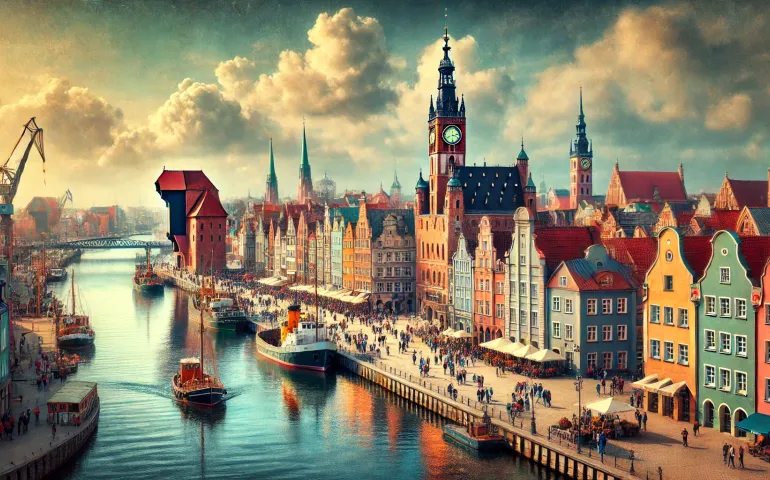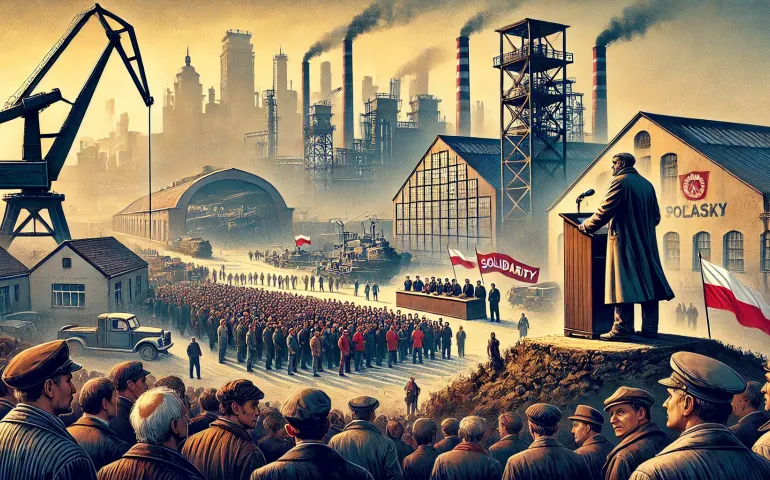About Place
- "A hidden gem on the Baltic coast."
- "Rich in history and culture with a vibrant port city atmosphere."
- "Stunning architecture and a picturesque old town."
Reasons to Visit
- Historical Significance: Gdańsk is a city steeped in history, playing a pivotal role in World War II as the location where the war began. The city's rich past is visible in its beautifully restored old town, featuring historical landmarks such as the Gothic St. Mary's Church, one of the largest brick churches in the world, and the Gdańsk Crane, a symbol of the city's medieval port life.
- Unique Architecture: The city boasts a stunning mix of architectural styles, from Gothic and Renaissance to Baroque. The Long Market (Długi Targ) is a prime example, lined with colorful, intricately designed merchant houses. The Golden Gate and the Green Gate are also must-see landmarks that showcase the city's architectural heritage.
- Cultural Vibrancy: Gdańsk is a cultural hub, home to numerous museums, galleries, and theaters. The European Solidarity Centre is particularly noteworthy, commemorating the Solidarity movement that played a crucial role in the fall of communism in Eastern Europe. The city also hosts various festivals and events throughout the year, such as the St. Dominic's Fair, one of the oldest and largest trade and cultural events in Europe.
Visa
- EU/EEA/Swiss Citizens: No visa required for stays up to 90 days.
- US, Canada, Australia, New Zealand, Japan, South Korea: Visa-free for up to 90 days within a 180-day period.
- Other countries: Check with the Polish consulate for specific requirements, as some nationalities will need to apply for a Schengen visa.
Travel Expenses
1. Travel to & from Destination:
- Flight Cost: Approx. $200 per person round trip from a major European city to Gdańsk (GDN).
- Total for two people: $400.
2. Hotel Cost:
- Average cost per night: $100 for a mid-range hotel.
- Total for 4 nights: $400.
- Total for two people: $400.
3. Food Cost:
- Average cost per meal: $20 per person.
- Total for 3 meals per day for 2 people over 4 days: $480.
4. Activity Cost:
- Museum and attractions entrance fees: $50 per person.
- Total for two people: $100.
5. Near Destination Travel Cost:
- Car rental and public transport: Approx. $150 for the trip.
- Total for two people: $150.
Total Estimated Travel Expenses: $1,530

Best Itinerary
Day 1: Exploring the Old Town Start your day with a visit to the Main Town Hall, which offers panoramic views of Gdańsk. Spend the morning strolling down Long Lane and Long Market, admiring the colorful facades and historical landmarks. Stop for lunch at Pierogarnia Mandu Centrum to try traditional Polish pierogi. In the afternoon, visit the Artus Court and Neptune Fountain. For dinner, head to Goldwasser Restaurant for a taste of Polish cuisine with a modern twist. End the night with a walk along the Motława River, taking in the illuminated views of the Gdańsk Crane and historic waterfront.
Day 2: Maritime Heritage and Solidarity Begin with a visit to the National Maritime Museum and the Gdańsk Crane to learn about the city's maritime history. For lunch, enjoy seafood at Targ Rybny. In the afternoon, head to the European Solidarity Centre to explore the history of the Solidarity movement. Dine at the Brovarnia Gdańsk, known for its craft beers and Polish dishes. In the evening, take a stroll through the Oliwa Park and visit the Oliwa Cathedral for a peaceful end to the day.
Day 3: Artistic and Cultural Discoveries Start your day at the Museum of the Second World War, one of the largest museums dedicated to WWII. Have lunch at Restauracja Kubicki, a historic eatery with traditional fare. In the afternoon, explore the Gdańsk Shakespeare Theatre and the Gdańsk National Museum. For dinner, try the unique dishes at Metamorfoza, a restaurant known for its innovative Polish cuisine. Spend your night enjoying the lively atmosphere of Mariacka Street, filled with amber shops and cozy cafes.
Day 4: Day Trip to Sopot and Gdynia Take a day trip to the nearby coastal towns of Sopot and Gdynia. Start with a walk on Sopot's famous pier, the longest wooden pier in Europe. Have lunch at Bulaj in Sopot, known for its seaside views and fresh seafood. In the afternoon, visit Gdynia's ORP Błyskawica, a historic warship museum. Return to Gdańsk for dinner at Fellini, an Italian restaurant with a Polish twist. Finish your trip with a nightcap at one of Gdańsk's many cozy pubs.

Safety Tips
- Keep your belongings secure and be aware of pickpockets.
- Stay in well-lit, populated areas, especially at night.
- Use licensed taxis or rideshare services.
- Be cautious when withdrawing money from ATMs.
- Carry a copy of your passport and visa at all times.
- Know the local emergency numbers.
- Avoid discussing sensitive political topics in public.
- Respect local customs and dress codes.
- Drink responsibly and never leave your drink unattended.
- Stay informed about local news and weather conditions.
Flights
- LOT Polish Airlines: Direct flights from major European cities to Gdańsk.
- Lufthansa: Flights with a layover in Frankfurt or Munich.
- Ryanair and Wizz Air: Budget airlines offering direct flights from various European cities.
Hotels
- Radisson Blu Hotel: Located in the heart of the old town.
- PURO Gdańsk Stare Miasto: Modern design with great amenities.
- Hilton Gdańsk: Overlooking the Motława River.
- Q Hotel Grand Cru Gdańsk: Boutique hotel with stylish decor.
- IBB Hotel Dlugi Targ: Centrally located on Long Market.
Contacts
- Indian Embassy in Warsaw: +48 22 583 1010
- Police: 112
- Ambulance: 999
- Firefighters: 998
Country
Closet Airport
- Gdańsk Lech Wałęsa Airport (GDN)
Nearest City
- Warsaw
Heritage Sites
Historic Centre of Gdańsk
Airlines
- LOT Polish Airlines
- Lufthansa
- Ryanair
- Wizz Air
- Norwegian Air Shuttle
Currency
- Polish złoty (PLN)
Languages Spoken
- Polish
Real Story
The Solidarity Movement: In the 1980s, Gdańsk became the epicenter of a significant social and political movement that would eventually lead to the fall of communism in Eastern Europe. The Solidarity movement, led by Lech Wałęsa, began in the Gdańsk Shipyard, where workers went on strike in August 1980. This strike was a response to rising food prices and poor working conditions, but it quickly grew into a broader demand for political reform and workers' rights.
The strikers formed the Independent Self-governing Trade Union "Solidarity" (Solidarność), which gained widespread support across Poland. The movement's ability to unite workers, intellectuals, and the Catholic Church made it a powerful force against the communist regime. Solidarity's demands included the right to form free trade unions, the release of political prisoners, and greater civil liberties.
The Polish government, under pressure from the Soviet Union, initially attempted to suppress the movement through martial law and arrests of its leaders. However, Solidarity continued to operate underground, maintaining its influence and support among the Polish population. The movement's resilience and the growing economic and political pressure eventually forced the government to negotiate with Solidarity.
In 1989, these negotiations led to the Round Table Talks, which resulted in semi-free elections. Solidarity's victory in these elections marked the beginning of the end for communist rule in Poland. Lech Wałęsa, the leader of Solidarity, went on to become the first democratically elected president of Poland in 1990.
The impact of the Solidarity movement extended beyond Poland's borders, inspiring other Eastern European countries to pursue democratic reforms. The fall of the Berlin Wall and the subsequent collapse of communist regimes in Eastern Europe can be traced back to the momentum generated by the events in Gdańsk.
Cuisine
Gdańsk's cuisine reflects its coastal location and historical influences. Traditional dishes often feature fresh seafood, meats, and locally sourced ingredients. A must-try is the famous "pierogi," Polish dumplings filled with various ingredients such as meat, cheese, or mushrooms. Another local specialty is "bigos," a hearty hunter's stew made with sauerkraut, meat, and sausages.
Seafood lovers should not miss the "śledź w śmietanie," herring in sour cream, a popular appetizer. For a sweet treat, try the "piernik," a traditional Polish gingerbread that has been a staple in Gdańsk for centuries. The city's vibrant culinary scene offers a mix of traditional Polish dishes and contemporary cuisine, making it a delightful destination for food enthusiasts.

Culture and History
Gdańsk's culture is a blend of Polish, German, and Baltic influences, reflecting its complex history. The city has been a significant port and trading hub since the medieval period, which has contributed to its diverse cultural landscape. This cultural richness is evident in the city's festivals, music, art, and cuisine.
The architecture in Gdańsk is a testament to its historical wealth, with Gothic, Renaissance, and Baroque styles prominently displayed throughout the city. The old town, meticulously rebuilt after World War II, offers a picturesque setting with its colorful facades, ornate gables, and cobblestone streets.
Gdańsk is also known for its amber, often referred to as "Baltic gold." The city has a long tradition of amber craftsmanship, and visitors can explore this heritage at the Amber Museum or shop for unique amber jewelry in the many local boutiques.
Cultural events are plentiful in Gdańsk. The St. Dominic's Fair, held annually in August, is one of Europe's oldest fairs, dating back to 1260. It features a vibrant mix of stalls, performances, and activities. The Gdańsk Shakespeare Festival is another highlight, celebrating the city's historical connection to the Bard with performances and workshops.
Music is an integral part of Gdańsk's cultural scene. The city is home to the Polish Baltic Philharmonic, and various music festivals, such as the Gdańsk Music Festival and the Siesta Festival, attract artists and audiences from around the world.
